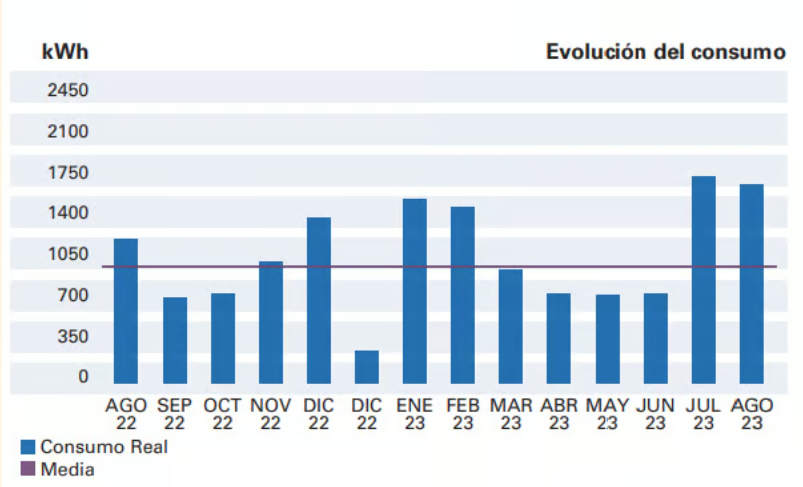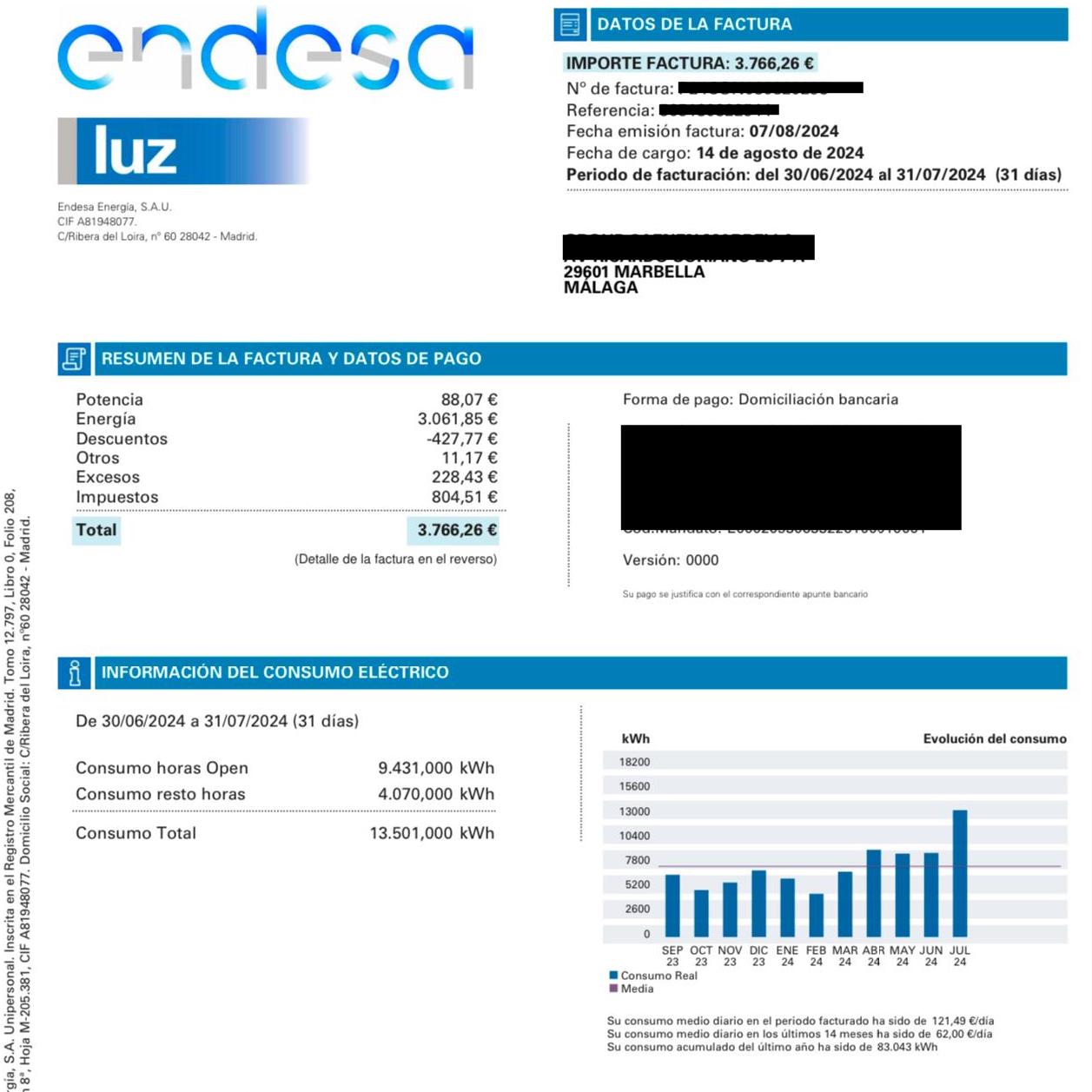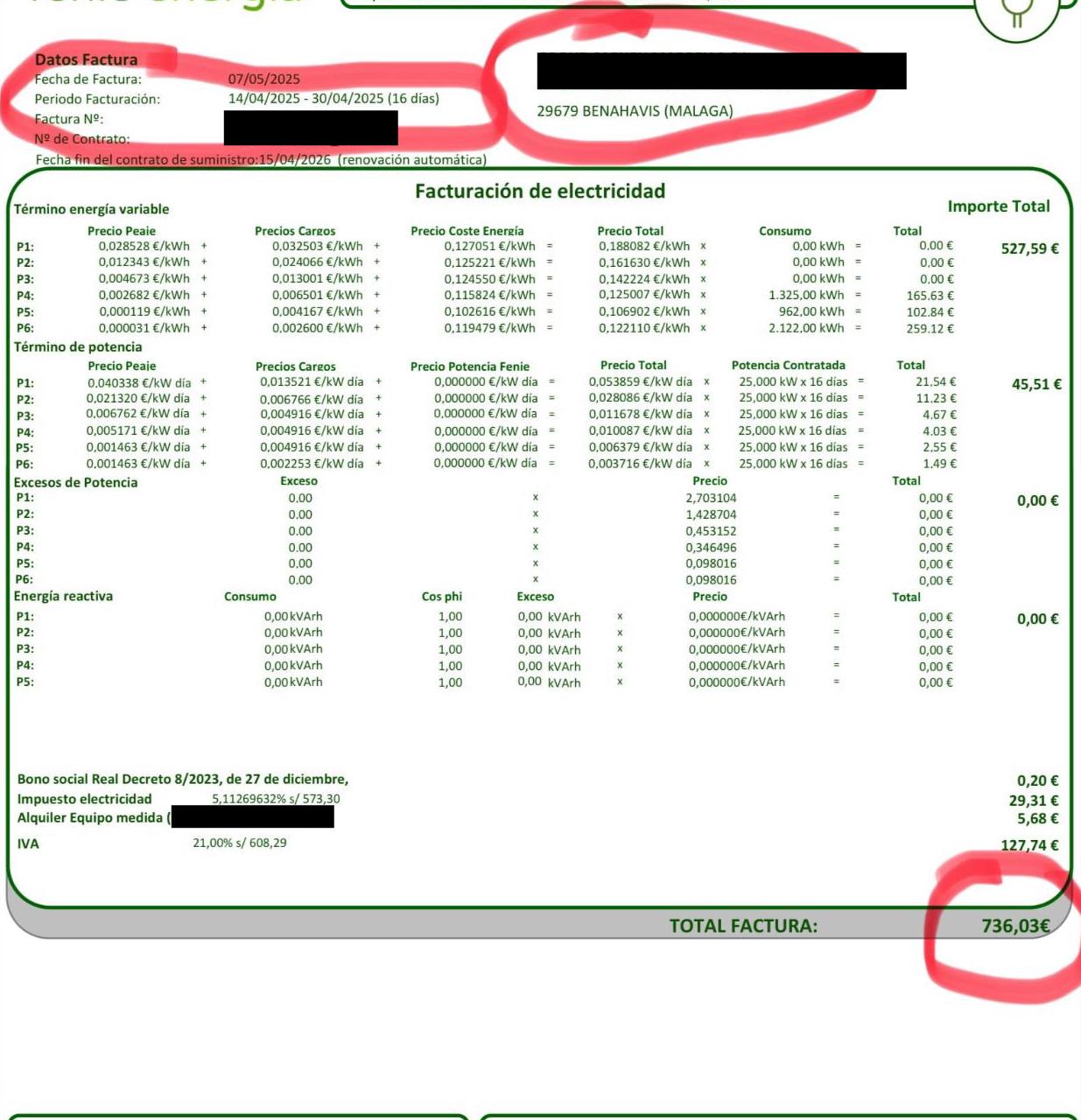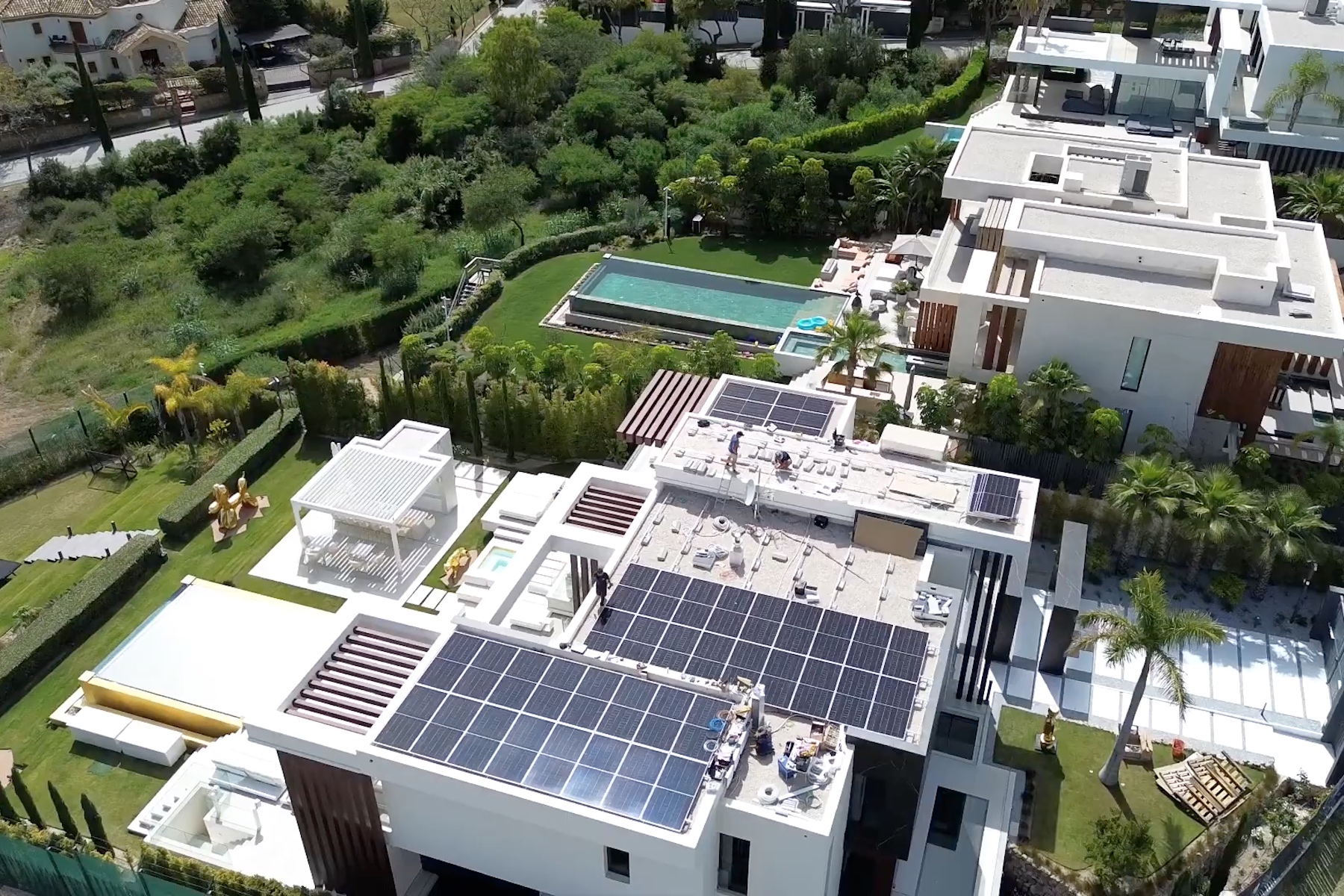
Roman is the owner of Marblanc Solar. He is an accredited civil engineer with a BEng (Hons), following four years of training in civil, structural, ground and construction engineering at the University of the West of Scotland.
If you’re interested in installing solar panels at your home in Marbella, then this post could help you save thousands in the coming years.
Here’s why.
We recently visited a homeowner in El Rosario, Marbella, who was paying €400-500/ month on electricity after installing solar with a different company. The high cost was because:
- The homeowner already had a large electric bill (about €800/ month before going solar).
- The system wasn’t properly sized.
- The installation wasn’t legalised.
- Their home electrics weren’t optimised to reduce grid reliance.
We recommended a series of fixes to the installation and were able to cut the client’s monthly electric bills down to around €160/ month, which amounted to an 80% reduction, compared to how much it was before going solar.
In this five-step guide, we’ll cover the most important considerations, so you can avoid a situation like this and maximise your savings with solar.
Let’s get into it!
Marblanc Solar is the top-rated solar installer in Marbella and the surrounding areas on the Costa del Sol in Spain. We offer homeowners a free site visit, drone inspection and savings estimation as part of our free solar survey.
Step 1: Sizing Your System
Sunny Marbella and its Solar Potential
So, you’re considering installing solar panels in Marbella? Well, you’re in luck!
This coastal city gets over 3,000 sun hours per year, with a daily average of 11-12 hours in summer and 7-8 hours in winter. Here’s the breakdown by month, based on data from World Weather Online:
| Month | Average sun hours | Average hours of sun per day |
| January | 225.9 | 7.3 |
| February | 210.5 | 7.5 |
| March | 210.8 | 6.8 |
| April | 234.1 | 7.8 |
| May | 299.2 | 9.7 |
| June | 327.7 | 10.9 |
| July | 358.7 | 11.6 |
| August | 346.9 | 11.2 |
| September | 293.9 | 9.8 |
| October | 270.3 | 8.7 |
| November | 249.1 | 8.3 |
| December | 243.5 | 7.9 |
In fact, compared to some other parts of Europe, Marbella gets almost double the number of sun hours per year. Here’s a comparison:
| Location | Average annual sun hours | Average annual sunny days |
| Marbella | 3,271 | 328 |
| Paris | 1,799 | 280 |
| London | 1,433 | 278 |
| Stockholm | 1,680 | 261 |
A Deeper Look into Sizing Your Solar Energy System
If you’re considering installing solar, you may be asking yourself: How many solar panels do I need? Or, Should I install a battery or not?
Before installing solar, the first step is to understand how many panels you actually need. At Marblanc Solar, we aim to cut our clients’ bills by 80% or more.
Let’s take a deeper look at sizing a system that can achieve this:
- First, have a look at your latest electricity bill and find a graph showing your consumption over the past year (see below).
- Find a kWh figure that’s between the highs and lows.
- Divide this figure by 30 to understand your average daily usage (in kWh).
- Then, divide your daily usage (in kWh) by the average number of peak sun hours per day in Marbella (six hours).

Let’s take an example:
- The image above shows an average monthly consumption of around 1,050 kWh.
- Average daily consumption is therefore around 35 kWh.
- With an average of six hours of peak sun per day in Marbella, we’d need at least a 5.8 kW system in order to be able to cut electricity bills by around 80%.
Of course, there are many more factors at play. But this rough calculation helps to get close to the right system size figure.
How Many Solar Panels Do You Need?
Understanding your ideal system size is only the first step, the next is understanding how many panels you need.
Solar panels come with different power outputs (measured in watts). Solar panels in Spain, for example, typically range between 300 W and 565 W.
So, if you wanted a 5.8 kW system, the number of panels will depend on the output size of the panel. For example, you’d need:
- 20 x 300 W solar panels (6 kW system)
- 13 x 450 W solar panels (5.85 kW system)
- 11 x 565 W solar panels (6.215 kW system)
Step 2: Considering Batteries
Do You Need a Solar Battery?
These calculations give you a rough idea of what you need.
But it’s rarely that simple.
To operate at their peak output, solar panels need to be in full sun, south-facing and be installed at an appropriate angle.
You may also have significant night-time consumption. For example, if you run appliances like underfloor heating, pool heaters, air conditioning or an electric car charger at night. In this case, you may need a solar battery in order to cut your electricity bills by 80%, or more.
This was the case for an installation we competed in Benahavís.
The client had a large villa with multiple high-power appliances running at night. One August, the client received a monthly electricity bill for €3,766. During our free solar survey, we explained that the solar installation must include a battery in order to achieve a significant bill reduction.
After installing 61 solar panels and 20.7kWh of solar batteries, the client received a new bill for €736, which amounted to an 81% reduction.


Step 3: Installation Costs
How Much Does it Cost to Install Solar Panels in Marbella?
Each project presents its own unique challenges that can influence the final cost. Nevertheless, here’s a quick breakdown of what you can expect:
For example, a small 5 kW solar system in Marbella can range from €5,000 to over €12,000, depending on the quality of materials installed and the difficulty of the installation. This cost includes all materials used and the installation fee, as well as labour and legal work.
Let’s break it down:
- The cost of the panels can range from €600 to €1,200 per kW.
- For the inverter, you can expect to pay between €1,000 and €2,000, depending on the size.
- The installation and labour can cost between €1,000 and €3,000, depending on the complexity of the installation.
- For the permits, boletín (see below) and inspections, you can expect to pay between €500 and €1,000.
What is the Boletín and Why is it Important?
You might think that can save money by installing the solar panels yourself – be warned!
In Spain, a certified electrician needs to sign off on your installation and register the system on the boletín or ‘bulletin’. With this registration, you gain the following benefits:
- You are eligible for solar incentives.
- You can access feed-in tariffs with your electricity provider.
- You avoid fines for unlicensed installations.
- You are guaranteed a quality installation and a low risk of technical issues, such as faulty wiring and system overloads.
If you live off-grid and are experienced in solar PV installations, you could consider installing yourself. But for the above reasons, it usually isn’t worth it for a grid-tied system.
Factors That Influence the Cost of Your Solar Panel Installation
Like we explained, every project is unique and presents its own challenges.
That being said, there are some factors we have observed that influence the cost of a solar installation. Here are some examples:
- The eventual price of your system depends on your electricity usage and ideal savings, which determines the size of the system you’ll need.
- Depending on the complexity of the installation – which can be impacted by things like the orientation of your roof, any shading or local building regulations – additional adjustments may have to be made, which may end up costing more.
- It also depends on if you are interested in additional equipment, such as solar batteries, backup storage in case of power outages, specific mounts, and so on.
For the installation below in Nueva Andalucía, Marbella, local building regulations required that the solar panels be mounted flat against the horizontal. This meant that more solar panels were needed. However, the client’s €2.900 monthly saving means the installation, in time, will pay for itself many times over.

Step 4: Solar incentives
IBI and EcoVivienda
Earlier this year, Marbella’s Ayuntamiento discontinued the reduction of Property Tax (IBI). Also, the Junta de Andalucía did not extend the EcoVivienda solar panel grant in 2025, which offered a payment equivalent to 40% of your installation costs.
But don’t worry, there are other solar incentives you can still benefit from.
The ICIO Tax Break
The construction, installation and works tax (ICIO) is a municipal tax that is levied on any construction, installation or renovation that requires a municipal license.
In Marbella, the tax rate for your solar panel installation is 4% of the total value of the work. This means if your installation costs €12,000, you will pay €480 in ICIO.
But, in order to encourage the installation of solar panels, Marbella offers a bonificación (or reduction) of 95%. That means an example tax of €480, for instance, would be reduced to just €24.
IRPF Tax Rebate from Junta de Andalucía
The Personal Income Tax (IRPF) is levied directly on the income earned by tax residents in Spain. If you install solar panels, however, you can reduce your taxable income.
In 2025, you qualify for a 60% deduction if the following requirements are met:
- The solar panel installation is complete and paid for before 31 December 2025.
- Non-renewable primary energy consumption is reduced by at least 30%, or an energy rating of ‘A’ or ‘B’ is obtained. The energy efficiency certificate must be issued before 1 January 2026.
- This deduction can be claimed for solar installations in all types of residential housing, except for those used for economic activities.
- The solar system must be destined for self-consumption and surpluses to the electricity grid not be used to generate income.
Labour, equipment, project drafting, materials and the energy efficiency certificates are all part of the taxable base.
Please note that while solar installation companies, such as Marblanc Solar, can supply the documentation necessary to apply for the IRPF deduction, you’ll need to apply for the deduction yourself in your annual declaración de la renta (tax return), or ask your gestor.
Reduced VAT Rates
The Spanish tax agency offers an attractive VAT reduction (from the usual 21% to 10%) for energy rehabilitation works, such as the installation of solar panels.
To qualify, the following conditions must be met:
- The completion of the energy rehabilitation works must exceed 50% of the total cost of the renovation project.
- If this first requirement is met, the total amount of the work must exceed 25% of the purchase price of the property (if this is carried out within two years prior to the start of the renovation works) or of the market value of the building prior to the renovation. In both these cases, the value of the land is not included.

Step 5: Maximising Your Savings
Daily Monitoring for Long-Term Savings
You’d be surprised, but it’s very common for homeowners to install solar and then use more electricity than before. They think they might as well, seeing as ‘it’s free’, and then the monthly bill comes as a surprise.
To avoid this situation, Marblanc Solar offers a post-installation service where we monitor your electricity consumption and solar production for two weeks.
This service recently helped a client of ours save an extra €300/ month on electricity.
The client was the owner of a large villa in Nueva Andalucía, Marbella, and received a monthly bill of €3,309, before deciding to go solar. Our installation of 39 solar panels cut his monthly bills to just over €700, a reduction of 79%.
And then, with the help of plug timers and optimised circuits, we cut the client’s bill down again, to €432, a total reduction of 87%.
A bill of this size is an extreme example. But it shows that monitoring consumption and reducing your grid usage as much as possible are the last remaining keys to long-term savings with solar.
Questions About Going Solar in Marbella?
Marblanc Solar is a solar installer and solar company based in Marbella, on the Costa del Sol, in Spain.
We install solar panels, solar batteries and solar inverters and help you switch to a new feed-in tariff with a virtual battery. As part of our post-installation support services, we help set up plug timers and optimised circuits to reduce your grid consumption as much as possible.
Want to find out more about going solar in Marbella, or the wider area?
Request our free solar survey and you’ll get a home visit, drone inspection, 3D shading analysis, savings estimation and custom proposal.
Schedule your free solar survey
The free solar survey includes: home visit, drone inspection, 3D shading analysis, savings estimation and custom proposal. Fill out the form and we’ll get back within one working day.
Free solar survey
